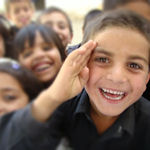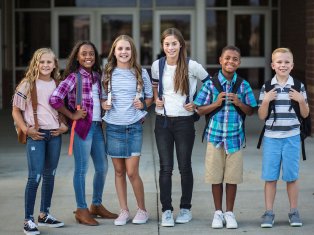
Before my daughter entered elementary school, I knew she learned differently from other kids.
But I always imagined that no matter how she learned, her future teachers would create an environment where she would thrive and we would work as partners to support her learning. My view of education was broad and I saw learning as a life-long process involving many levels of knowledge.
I expected a flexible system that would place my child at the center and where her teachers, school administrators, after-school program leaders, and family would work together to benefit her development.
Needless to say, the way I viewed education was not the way our system worked. After all, today’s school system was built on mechanistic ideas from the Industrial Revolution, designed to produce graduates like machines produce widgets. Like an assembly line, children enter at kindergarten and progress grade by grade until they graduate around the age of eighteen. Its sole purpose is to produce “well-educated children” who go on to adulthood and the world of work. When children move at a pace that is different from the machine, they are often labeled as having deficits. This creates a big problem for the system. Schools try to help these kids by suggesting drugs to help them focus or by tutoring them to stay on track.
Don’t get me wrong. I’m not suggesting that learning deficits and disabilities do not exist. Like Sir Ken Robinson’s views expressed in the video below, I believe the modern epidemic of ADHD and other diagnosis are given to kids who do not fit into our inflexible, mechanistic school system. My daughter had many labels during her school years, none of which truly captured the unique and capable child she was. One year she would be diagnosed with an auditory processing weakness, the next year a different specialist would suggest she had attention deficit disorder, and yet another would label her with high-functioning Asperger’s Syndrome. She probably had more than ten different diagnoses throughout high school and college.
This deficit theory of education is based on a belief that children lack what they need to learn. The school’s job is to make up for this deficit. Teachers tell parents where their kid’s deficits are through report cards; many specialized tests help brand children with specific disabilities. However, few opportunities exist for parents and schools to work in partnership to develop kids’ ability to learn. Why? If we look at education as a mechanistic process, we do not build in flexibility nor recognize the importance of learning that is outside the system itself. Education and learning become separated rather than interrelated.
In the article The Objective of Education is Learning, Not Teaching, the Wharton Business School excerpted a key message from the book, “Turning Learning Right Side Up: Putting Education Back on Track,” by Russel L. Ackoff and Daniel Greenberg. The article explored how systems from the Industrial Age have contributed to our current dilemma and suggested a new focus on how children learn rather than how well they are taught.
21st Century Learning
 It is quite natural for children to learn, even without school. Children in tribal cultures learn from their elders and from being a part of a societal system. Children learn by being members of families, through trial and error, and through exploration. The rise of homeschooling is a response by many parents to bring education and learning together, to help children build on strengths in supportive, nurturing, and more natural learning environments.
It is quite natural for children to learn, even without school. Children in tribal cultures learn from their elders and from being a part of a societal system. Children learn by being members of families, through trial and error, and through exploration. The rise of homeschooling is a response by many parents to bring education and learning together, to help children build on strengths in supportive, nurturing, and more natural learning environments.
In the revolution that is now occurring in science, we are beginning to understand that we cannot control the world in ways we once believed. Systems-thinking, a process of understanding how parts influence the whole, teaches us that learning occurs through relationships, collaboration, and flexibility, not through the memorization of rote facts. Peter Senge, author of The Fifth Discipline: The Art and Practice of the Learning Organization, acknowledges that changes in scientific thinking must somehow reach to our schools where education begins. He admits it is more difficult to bring about change in public education because the mechanistic metaphor is so deeply entrenched in our thinking.
Another assumption rooted in the Industrial Era is that learning occurs in the head, not the body. Hence, most of what is taught in schools is left-brain focused. We now know that learning occurs in both sides of the brain and the body. By limiting the way we teach, we also limit development. We miss the importance of psychological literacy — emotional intelligence, kinesthetic and interpersonal abilities, spirituality, moral reasoning, and critical thinking — that characterize the many areas of positive development.
Traditional education teaches knowledge through subject or categorized areas. Our kids study literature, mathematics, and biology. But in fact, life presents itself to us as a whole, a system of interconnected knowledge. This fragmented view of knowledge is antithetical to systems-thinking and the kinds of skills needed in the 21st century.
Changing Education Paradigms
The following video, created by a visual facilitator, depicts the messages in Sir Ken Robinson’s TED talk about the history of education and why today’s reformers have it wrong. Sir Ken Robinson, PhD, is an internationally recognized leader in education, creativity and innovation. If you are not one of the 5 million people who have viewed this, I encourage you to do so now!
Parents, Schools, and Communities Make a Difference
Collaboration is essential to innovation. When the school system didn’t work for my child, I collaborated with others to create change. Fifteen years ago, when my daughter was in 8th grade, I worked with hundreds of parents, school administrators, and teachers to develop ParentNet, now known as Washington State Family and Community Engagement Trust, a program that brings parents and schools together to learn from each other about raising healthy, successful kids. There were no hard and fast rules; no right and wrong answers. Coming together only required a willingness to share and grow through respect and collaborative learning. Not surprisingly, ParentNet became more successful in private schools because of their more flexible and adaptive environments.
I believe grassroots efforts by parents and teachers who see better possibilities in education will eventually help school systems adapt to 21st century needs. I remain as committed today as I was 15 years ago to working for all children, not just my own. My own daughter, who tested in the lowest percentile for a variety of skills, recently graduated from law school. She will always learn differently from others and struggle to fit in, but she is nonetheless a productive, healthy, and engaged young woman.
Don’t wait for education reformers to fix the system! Education and learning CAN coexist if we act in ways that truly benefit kids. Get involved. Get others involved.
Photo Credit: David Castillo Dominici
Published: August 22, 2011
Tags: critical thinking, education, Family-School Partnerships, learning, positive youth development, reasoning, Spirituality, teachers, Underserved Youth, youth development approach


